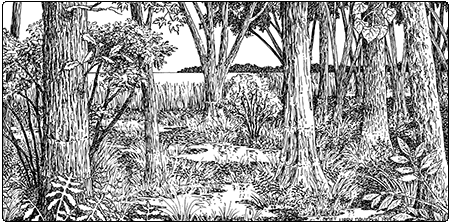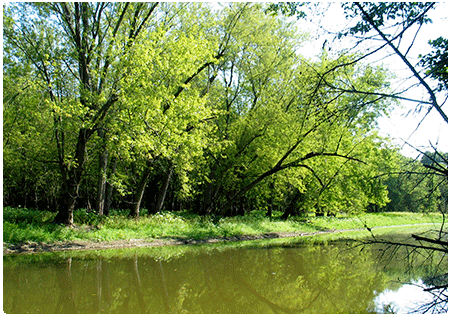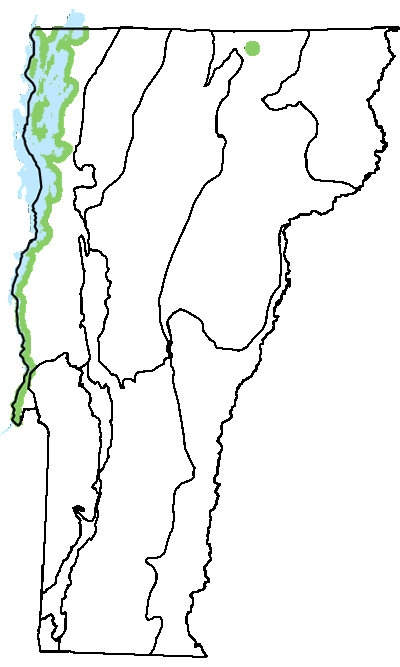Ecology and Physical Setting 
Lakeside Floodplain Forests typically occur in former lake coves, and within complexes of marshes and swamps at the mouths of rivers and streams. When this community occurs in an old lake cove, there is often a narrow beach ridge along the lake. A marsh or Lakeside Buttonbush Swamp may occur in the deepest portion of the former cove, just behind the beach ridge. Next, a Maple-Green Ash Swamp may be present on organic soil landward of the buttonbush swamp. The Lakeside Floodplain Forest is usually beyond that, farthest from the lake and adjacent to the upland. There are, however, many variations on this pattern.
The soils of Lakeside Floodplain Forests are typically silt or clay loams. The soils are derived from lake sediments and alluvial deposits. Annual lake flooding deposits very fine soils and contributes to the rich growing conditions in these forests. Surface organic layers may be several inches thick, but where mineral soil is predominant, mottling is usually present to the surface. Although lake levels drop by summer, the soils in Lakeside Floodplain Forests typically remain moist because they are fine textured and they hold water.
 Lake Champlain reaches its highest water levels during the months of April, May, and June, when the average maximum level is almost 100 feet. Lakeside Floodplain Forests are found below this elevation, but above the average lake level during the growing season—an elevation difference of only a few feet. Extended high-water periods in the spring mean that plants in Lakeside Floodplain Forests must tolerate longer periods of inundation than plants in riverine floodplain forests. It is not uncommon to see dead saplings and trees in the lowest portions of Lakeside Floodplain Forests because, in rare years, high lake levels may persist into the growing season.
Lake Champlain reaches its highest water levels during the months of April, May, and June, when the average maximum level is almost 100 feet. Lakeside Floodplain Forests are found below this elevation, but above the average lake level during the growing season—an elevation difference of only a few feet. Extended high-water periods in the spring mean that plants in Lakeside Floodplain Forests must tolerate longer periods of inundation than plants in riverine floodplain forests. It is not uncommon to see dead saplings and trees in the lowest portions of Lakeside Floodplain Forests because, in rare years, high lake levels may persist into the growing season.
Very slight changes in elevation in Lakeside Floodplain Forests appear to have substantial impacts on the herb, shrub, and sapling layers. The lowest parts of the lakeside floodplain have sparse herbs, but may have dense thickets of silver maple seedlings. Slightly higher on the floodplain, marsh fern is common, and in areas elevated several inches more, winterberry holly and sensitive fern dominate the herb and shrub layers.
Vegetation
Lakeside Floodplain Forests are typically dominated by silver maple, with a strong green ash component. There are very few shrubs and a sparse ground cover that includes whitegrass, beggar’s ticks, and, closer to the swamp, water willow. Silver maple seedlings may nearly cover the ground in some areas, but few survive the flooding of the following spring.

maple trunks are signs of extended high water periods.
This low diversity forest grades into a slightly higher elevation silver maple forest closest to the uplands. Green ash is an important component of the canopy, with swamp white oak occurring occasionally. Green ash is especially tolerant of flooding. In mature forests, the tall, stately silver maples and green ash may reach heights of 100 feet and diameters of three feet. Silver maple and green ash seedlings and saplings are abundant, and there are scattered patches of winterberry holly. Sensitive fern is the dominant herb; it may cover much of the forest floor. Although seldom abundant, false nettle is characteristic. Other herbaceous species include whitegrass, marsh fern, beggar’s ticks, and Tuckerman’s sedge. The uncommon cattail sedge, yellow water-crowfoot, and Gray’s sedge are all closely associated with Lakeside Floodplain Forests.
The narrow beach ridge adjacent to the lake can also have vegetation very similar to Lakeside Floodplain Forests, but it varies with the substrate of the beach ridge.
Wildlife Habitat
Lakeside Floodplain Forests provide habitat for several bird species that use deciduous forests near open water for breeding: veery, yellow warbler, warbling vireo, yellow-throated vireo, and northern oriole. Several rare breeding bird species may also be found in these wet, lakeside forests, including blue-gray gnatcatcher, cerulean warbler, and red-shouldered hawk. The large dead silver maple and green ash that frequently occur at the lakeward side of these forests provide nesting cavities for wood ducks, mergansers, and common goldeneyes. Pileated woodpeckers may be responsible for creating some cavities used by these ducks. Great blue herons establish nesting rookeries in the tall silver maples, and green herons and black-crowned night herons use these trees as perches and for nest sites. Mink and raccoon are common in this community, and their tracks are frequently seen in the bare muddy soils. Northern leopard frogs may be abundant, especially in forest openings near water. The musical trill of male gray treefrogs calling from overhead tree branches on spring and early summer evenings is a magical sound.
Related Communities
- Silver Maple-Sensitive Fern Floodplain Forest is very similar in vegetation to Lakeside Floodplain Forest. It differs in that it occurs adjacent to rivers, has soils formed from annual alluvial deposition, and typically has shorter duration flooding than Lakeside Floodplain Forest.
Conservation Status and Management Considerations
Due to their lengthy spring flooding, Lakeside Floodplain Forests have not been as extensively cleared for agricultural uses as Riverine Floodplain Forests. Lakeside Floodplain Forests would be threatened by any significant alteration of water levels in Lake Champlain by changing flows into the Richelieu River. There are high quality examples of this community on private land, and several examples are protected on conserved lands.
Distribution/Abundance 
In Vermont, Lakeside Floodplain Forests have been identified from the shores of Lake Champlain, and there are small examples on the shores of Lake Memphremagog. It has not been described elsewhere in the region.
Characteristic Plants
Trees
Abundant Species
Silver maple – Acer saccharinum
Green ash – Fraxinus pennsylvanica
Occasional to Locally Abundant Species
Swamp white oak – Quercus bicolor
American elm – Ulmus americana
Cottonwood – Populus deltoides
Black willow – Salix nigra
Freeman’s maple – Acer ×freemanii
Shrubs and Vines
Occasional to Locally Abundant Species
Winterberry holly – Ilex verticillata
Buttonbush – Cephalanthus occidentalis
Riverbank grape – Vitis riparia
Poison ivy – Toxicodendron radicans
Herbs
Abundant Species
Sensitive fern – Onoclea sensibilis
Occasional to Locally Abundant Species
False nettle – Boehmeria cylindrica
Marsh fern – Thelypteris palustris
Whitegrass – Leersia virginica
Common beggar’s-ticks – Bidens frondosa
Tuckerman’s sedge – Carex tuckermanii
Blue flag – Iris versicolor
Swamp candles – Lysimachia terrestris
Wild mint – Mentha arvensis
Wood nettle – Laportea canadensis
Water willow – Decodon verticillatus
Hop sedge – Carex lupulina
Cardinal flower – Lobelia cardinalis
Spotted water-hemlock – Cicuta maculata
Non-native Invasive Plants
Moneywort – Lysimachia nummularia
Rare and Uncommon Plants
Cattail sedge – Carex typhina
Gray’s sedge – Carex grayi
Yellow water-crowfoot – Ranunculus flabellaris
Green dragon – Arisaema dracontium
Black gum – Nyssa sylvatica
Lance-leaved loosestrife – Lysimachia lanceolata
False hop sedge – Carex lupuliformis
Mild water-pepper – Persicaria hydropiperoides
Foxtail sedge – Carex alopecoidea
Associated Animals
Gray treefrog – Hyla versicolor
Northern leopard frog – Lithobates pipiens
American bullfrog – Lithobates catesbeianus
Green frog – Lithobates clamitans
Mink – Neovison vison
Raccoon – Procyon lotor
Great crested flycatcher – Myiarchus crinitus
Warbling vireo – Vireo gilvus
Veery – Catharus fuscescens
Yellow warbler – Setophaga petechia
Baltimore oriole – Icterus galbula
Yellow-throated vireo – Vireo flavifrons
Wood duck – Aix sponsa
Hooded merganser – Lophodytes cucullatus
Common merganser – Mergus merganser
Mallard – Anas platyrhynchos
Pileated woodpecker – Dryocopus pileatus
Great blue heron – Ardea herodias
Green heron – Butorides virescens
Lance-tipped darner – Aeshna constricta
Rare and Uncommon Animals
Red-shouldered hawk – Buteo lineatus
Blue-gray gnatcatcher – Polioptila caerulea
Cerulean warbler – Setophaga cerulea
Osprey – Pandion haliaetus
Black-crowned night-heron – Nycticorax nycticorax
Common Goldeneye – Bucephala clangula
Ground beetle – Olisthopus micans
Places to Visit
Little Otter Creek Wildlife Management Area, Ferrisburgh, Vermont Fish and Wildlife Department (VFWD)
Sandbar Wildlife Management Area, Milton, VFWD
North Hero State Park, North Hero, Vermont Department of Forests, Parks, and Recreation
LaPlatte River Marsh Natural Area, Shelburne, The Nature Conservancy
